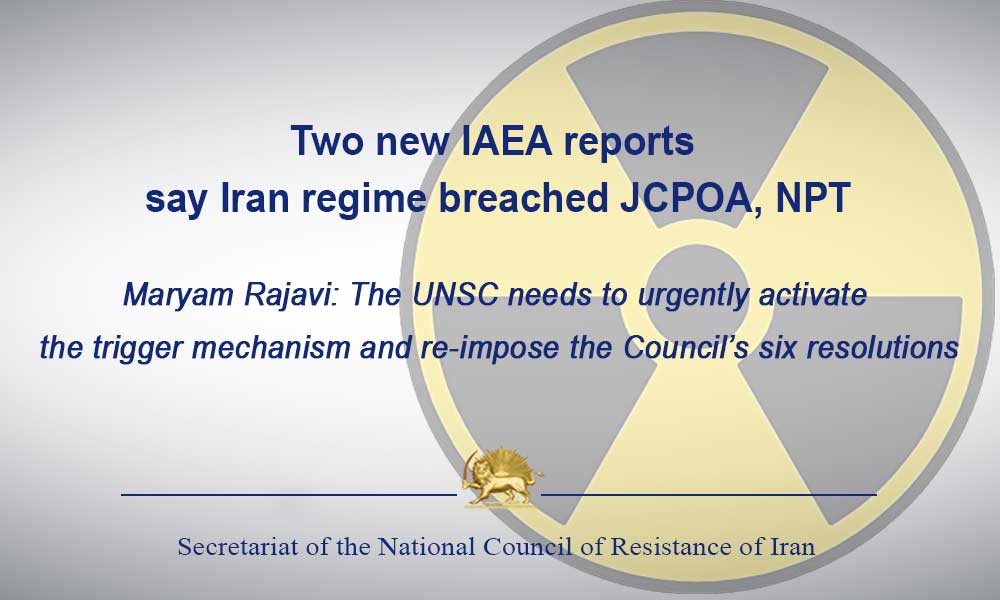IAEA: Iran regime in breach of Nuclear Non-Proliferation Treaty

Imperative to re-impose of the six UN Security Council resolutions, activate trigger mechanism
Two new reports by the Director-General of the International Atomic Energy Agency (IAEA) to the IAEA Board of Governors on the Iranian regime’s nuclear program confirm the regime has repeatedly breached the Nuclear Non-Proliferation Treaty (NPT), and the Additional Protocol and violated the Joint Comprehensive Plan of Action (JCPOA).
One of the two reports, entitled “NPT Guarantee Agreement with the Islamic Republic of Iran,” underscores, “As a result of its ongoing evaluations, the Agency identified a number of questions related to possible undeclared nuclear material and nuclear-related activities at three locations in Iran that had not been declared by Iran.”
In its summary report, the IAEA adds, “The Agency notes with serious concern that, for over four months, Iran has denied access to the Agency, under Article 4.b.(i) and Article 5.c. of the Additional Protocol, to two locations and, for almost a year, has not engaged in substantive discussions to clarify Agency questions related to possible undeclared nuclear material and nuclear-related activities in Iran. This is adversely affecting the Agency’s ability to clarify and resolve the questions and thereby to provide credible assurance of the absence of undeclared nuclear material and activities at these locations in Iran.”
The second report on the regime’s adherence to its commitments under UN Security Council Resolution 2231 and the JCPOA, notes that as of May 20, the clerical regime’s total stockpile of low-enriched uranium amounted to 1,571.6 kilograms, and “on July 8, 2019, the Agency verified that Iran had begun enriching UF6 above 3.67% U–235 (para. 28). Since that date, Iran has been enriching uranium up to 4.5% U-235. Iran has also continued to conduct certain enrichment activities that are not in line with its long-term enrichment and R&D enrichment plan, as provided to the Agency on January 16, 2016 (para. 52). 24.” This is while the JCPOA allows only the enrichment of 3.67% enriched Uranium and the maximum storage of 202.8 kilograms.
New reports from the IAEA once again show that the Iranian regime has not abandoned its project to build an atomic bomb. Immediately after the signing of the nuclear deal on July 14, 2015, Mrs. Maryam Rajavi, the President-elect of the National Council of Resistance of Iran (NCRI) announced, “Circumventing six Security Council resolutions would not prevent the mullahs’ deception and the quest to obtain an atomic bomb.” Five years after the nuclear deal, the clerical regime’s breaches attest to this fact. The continued lack of transparency regarding the Possible Military Dimensions of its nuclear programs (PMD), the activities of the Organization of Defensive Innovation and Research (Farsi acronym: SPND), and the Center for Research and Expansion of Technologies for Explosion and Impact (Markaz-e Tahghighat va Tose’ e Fanavari-e Enfejar va Zarbeh), known by its Farsi acronym as METFAZ, are among such activities.
On January 6, 2020, Mrs. Rajavi, described the decision by the Iranian regime not to abide by “restrictions in the number of centrifuges, the capacity, percent, and level of enriched uranium and research and development,” in its nuclear program as a practical departure from the Iran nuclear deal. She underscored the imperative and urgency of activating the trigger mechanism and reinstating six United Nations Security Council resolutions against the regime and added that the anti-human regime used all benefits and concessions from the JCPOA to further export terrorism and warmongering abroad and carry out suppression at home.
Secretariat of the National Council of Resistance of Iran (NCRI)
June 9, 2020

